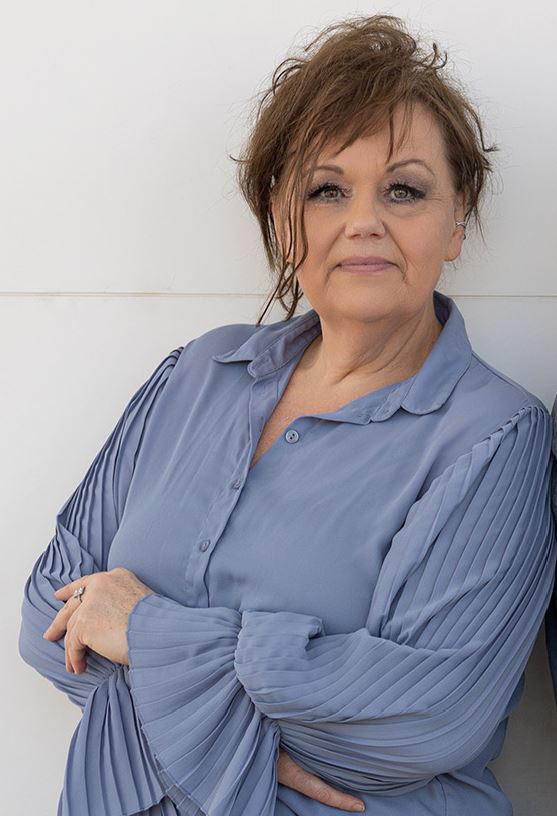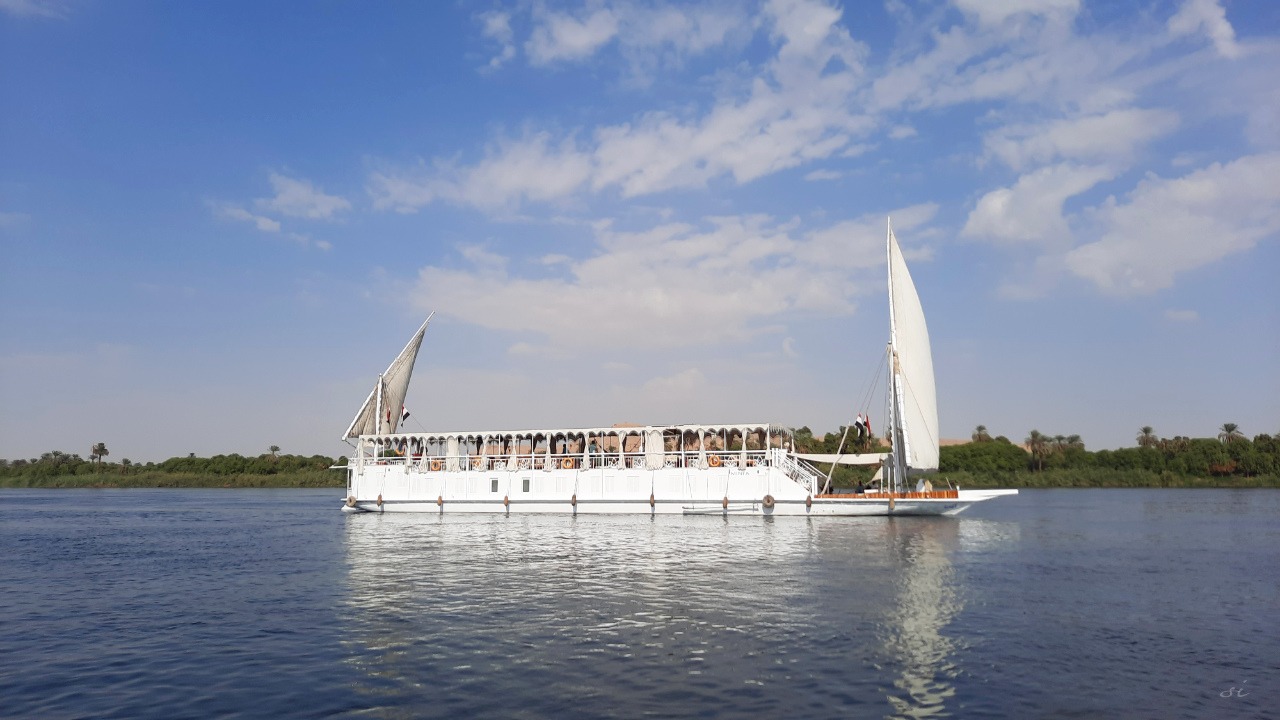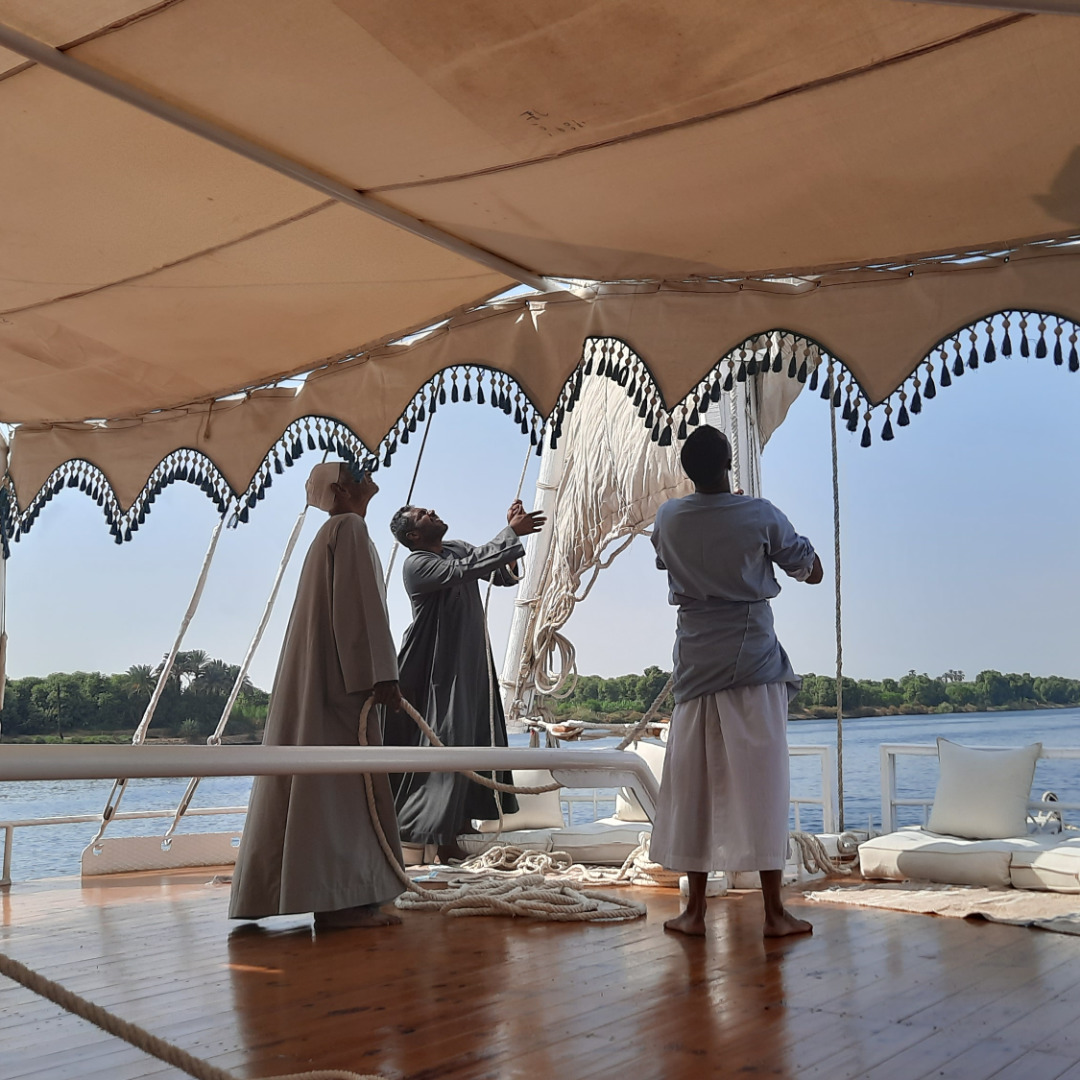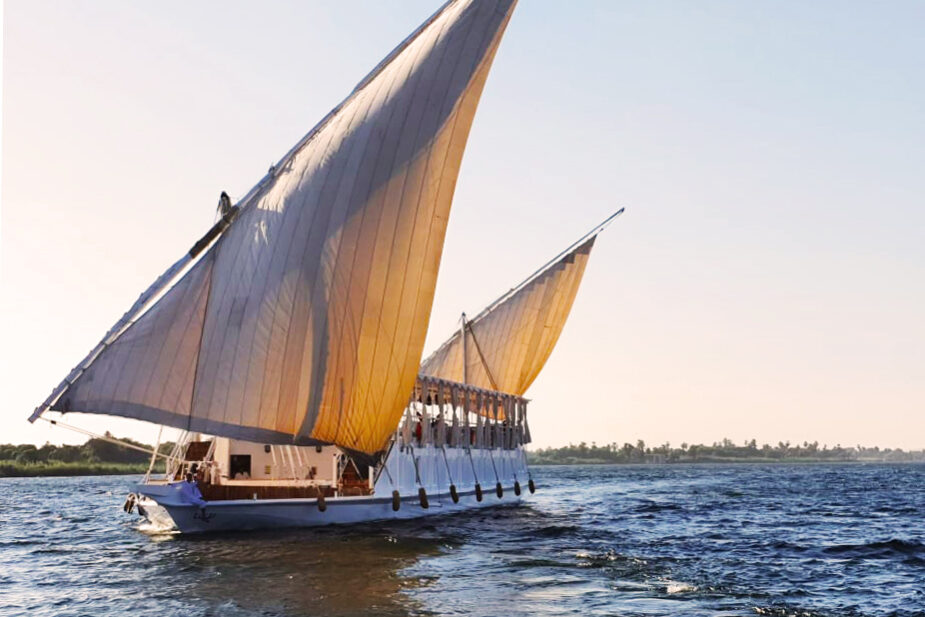Used by the Pharaohs of ancient Egypt, and once the sole mode of transport for rich Europeans seeking to explore the land of longing on the Nile at the dawn of tourism, the dahabiya is slowly coming back into fashion. An all-inclusive luxury expedition wherever the wind takes us, where the joys of slow travel and ancient Egypt meet. Romantic, yet intimate.
By Susanne Mauthner-Weber

A Journalist’s Journey: Susanne Mauthner-Weber Sails the Nile
We are honoured to welcome Austrian journalist Susanne Mauthner-Weber as a guest voice on our blog. With a career spanning decades at KURIER, Austria’s leading daily newspaper, Susanne has long been a passionate chronicler of history, science, and the human story. Her background in Law and Media Studies, paired with her deep curiosity about the ancient world—from paleogenetics to Egyptology—makes her perspective especially meaningful to us.
In her writing for leading history magazines and in acclaimed books such as “Zuhause ist anderswo. Eine Weltreise durch die Migrationsgeschichte von Ötzi bis heute” (“Home is elsewhere. A journey around the world through the history of migration from Ötzi to the present day”), she has explored humanity’s journey across time and continents. Now, her path brought her to the timeless banks of the Nile.
We’re delighted to share Susanne’s reflections on sailing with us aboard a traditional dahabiya—an experience that blends the comforts of slow travel with the profound richness of Egypt’s past.
When British author Amelia Edwards boarded the Philae on December 13, 1873 at around two in the afternoon, she took a step that would change her life forever. That Saturday, the dahabiya that would be her home for the coming months was moored on the eastern bank of the River Nile in Bulaq, a district of the Egyptian capital of Cairo. The favourable winds would soon speed the 42-year-old Londoner from Cairo to Abu Simbel. She wrote, “Happy are the Nile travellers who start thus with a fair breeze on a brilliant afternoon!” Past the great Pyramids of Gizeh, the stepped pyramid of Djoser in Saqqara, Beni Hasan, Dendera, Abydos, Luxor and Thebes, Karnak and Aswan – the following weeks would inspire probably the most famous travel writing ever written: A Thousand Miles Up the Nile.
WHAT IS A DAHABIYA?
Dahabiyas were forgotten for many decades. A strange irony of fate, given that these traditional boats were once the ultimate mode of transport down the Nile, long before the steam ships made famous by Agatha Christie and her Death on the Nile.
Dahabiyas have a history going all the way back to Pharaonic times. Inscriptions showing similar boats can be found in the tombs of the ancient Egyptian kings.
Dahabiyas were owned by many famous Egyptians, including King Farouk and President Anwar as-Sadat. The English writer, journalist, traveller and Egyptologist Amelia Edwards even ordered a piano for the salon of her own dahabiya. European aristocrats were particularly appreciative of these floating homes on their expeditions into ancient Egypt, which could often last as long as two or three months, until all the sights between Cairo and Abu Simbel (pre-Aswan Dam) had been visited.
The name of these storied sailing-boats has as many variations as the journeys they undertake. Don’t be surprised to encounter “dahabeeyah”, “zahabiya”, “dahabeyya”, “dahabiah”, “dahabiyah”, “dhahabiyya”, “dahabiyeh”, “dahabieh”, “dahabeah” or “dahabey” as well as “dahabiya”.
A book that defined the route of all Egyptian journeys for the decades to follow, and answered the question that may be on many people’s minds: What on earth is a dahabiya?
A “dahabeeyah”, wrote Edwards, was rather like “an Oxford University barge” at first glance: shallow and flat-bottomed, and adapted for either sailing or rowing. It was two-masted: “a big one near the prow and a smaller one at the stern. The cabins are on deck and occupy the after-part of the vessel; the roof of the cabins forms the raised deck, or open-air drawing-room […], the exclusive territory of the passengers. A dahabeeyah is, in fact, not very unlike the Noah’s ark of our childhood.” In fact, it reminded her of old pictures of the Bavarian royal barge on Starnberg Lake, “especially when the men are at their oars.” (See left for more about dahabiyas.)
Today, toiling at the oars has long passed into history and rowing has been replaced with towing by a small diesel-powered tug. But more of that later. The starting-point of the journey on these ancient sailing vessels has also moved, and today visitors cast off from Luxor and Ezna instead of Cairo to travel south, or, as we did, from Aswan to go north.

As the little group tumbles out of the minibus that has collected them from their hotel, their gaze first falls on a broad, lushly green strip of pasture on which bleating goats are busily grazing. Behind them, in the brilliant morning sun, is the incredibly blue River Nile, and on it the majestic, gleaming white Minya, our home for the coming days. The sun deck of this wooden beauty is decked out with blue-and-white hangings, their tassels bobbing in the light breeze. Waving a friendly welcome, the crew hurries to carry the luggage on board and serve the new guests with Egypt’s national drink – karkadeh, iced hibiscus tea.
Some years ago, the dahabiya’s owners – German-born Johanna Marius and Egyptian captain Mohammed Morsy – decided to augment their first boat, the Abundance, with a second built entirely to their own specifications. The new vessel was designed with six cabins and a suite for a maximum of 14 guests, who could luxuriate in the tasteful furnishings, elegant fabrics and polished wooden decks, glowingly colourful tiled bathrooms, and salon with its bookshelves and picture windows, like the aristocrats and upper-class travellers that once explored the land of the Pharaohs during the monarchist era.
But in the twenty-first century, life is mainly lived on deck; a bell tastefully calls the passengers to dine there, with a menu of Egyptian delicacies spanning hummus, baba ganoush, okra, Oriental rice, salads, omelettes, sweet pancakes and fig jam, washed down by fresh mango and guava juices. Not forgetting shrimps, fish and chicken to add touches of luxury. Head waiter Ahmed is flawlessly attentive, regularly coming over to ask “Anything more?” The meal is accompanied by the ethereal tones of wind chimes. A truly magical moment.

260 square metres flap and flutter. The barefoot crew struggle to regain control of the sail, which has taken on a mind of its own in the gusty wind. The cook, the waiter, the crew, and the captain in his long, flowing traditional djellaba, all lend a hand when the Minya‘s sail needs to be reefed. The captain needs fair winds to hoist the sails and loosen the rope to the tugboat. The Minya has a crew of nine, with six on board the boat itself and three in the tugboat. Like all genuine dahabiyas, it has no engine, only a generator to deliver power. As a result, it features something that is extremely rare in these bustling times: silence. All that can be heard is the gurgle of the river splashing against the boat, with undertones of birdsong and the call of the muezzin, but also the thrumming diesel engines in the distance.
Date palms and mango plantations glide past to left and right. Cows graze placidly alongside children playing on tiny islands in the river. Sometimes the landscape is entirely green before the orange of the desert once again sweeps down to the water’s edge. A huge cruise ship occasionally passes close at hand, its passengers throwing yearning gazes at the majestic sailing boat that seems to be a throwback to “Death on the Nile”, an era when the first travellers were discovering and exploring the world of wonders along the great river.

Before Thomas Cook sent his first two steamers out along the Nile and invented the package tour, dahabiyas offered the only possibility of travelling through Egypt. Images on the walls of the Pharaohs’ tombs provide evidence that these boats have existed for millennia in one form or another. Similar state vessels, richly gilded, were used by Egypt’s Muslim rulers in medieval times and gave the dahabiya its name – “the golden one”.
In 1847, Sir John Gardner Wilkinson noted in his Handbook for Travellers in Egypt: “Twenty days may be reckoned a fair average for the voyage from Cairo to Thebes; with fair winds, it is possible to go from Thebes to the second Cataract and back again in a fortnight, though this is rarely done; and the least time for seeing Egypt conveniently, is three months.”. Wilkinson also reported that when travellers hired a dahabiya, they were responsible for having their boat unloaded and repainted at the end of the journey, and warned that the boat captains required careful supervision.
Today travellers need not worry about a thing, free to embark on the pursuit of pleasure. “All comes to us as we travel thus”, wrote the German poet Rainer Maria Rilke in 1911 about the Nile to his wife Clara. But all in good time.

Only a few years ago, before contemporary society had (re)discovered the pleasures of slow travel, there were few dahabiyas plying the route along the Nile. “Today there must be 150 of them”, estimates Captain Mohammed. Many are of enormous size and hard to manoeuvre: “They can’t be sailed at all, they’re not proper dahabiyas any more”, he says dismissively.
Captain Mohammed has taken up his position in the bow. To have a clear view and direct the tugboat? “That as well”, he laughs, “but mostly, I want to enjoy the sunshine.” Mohammed has worked with boats since he was twelve, starting out on a felucca and progressing to skippering on other people’s dahabiyas. Now he is the captain of the Abundance and the Minya.
Today the Nile is full of traffic. We encounter an endless stream of dahabiyas, with sonorous names including Queen of the Nile, Princess Leia, Noor Eldin and Agatha Christie. More lie at anchor in Kom Ombo. All are painted white, with two sails and attractive covered sun decks. Originally built for carrying VIPs and royal families, the dahabiya is now returning to fashion. Our all-inclusive luxury package includes Saleh, a guide who today will introduce our small group to the highlights of the temple at Kom Ombo. He is highly qualified to do so; like all the guides employed by Johanna Marius and Mohammed Morsy on their boat, Saleh has studied Egyptology.
Because the shrine here is dedicated to Sobek, the crocodile-headed god of water and fertility, our guide tells us about the crocodile oracle: “The ancient Egyptians knew exactly when the floods would come. When the crocodiles laid their eggs, the fertile waters were never far away. And if the crocodiles laid their eggs close to the river, the floods would be moderate.” If the animals chose sites at a safe distance from the waterline, however, strong flooding could be expected.
In the evening we stop at an ancient quarry. The compact size of the dahabiya means that Captain Mohammed can moor anywhere he wants; the Minya needs neither harbour nor jetty. This enables us to explore the historical site at the perfect time of day – next morning, straight after breakfast. The quarry at Gebel El-Silisa was already used by the ancient Egyptians when they built the temples of Karnak, Luxor and Kom Ombo in the desert sands. Its pillars, tombs, graffiti and stones showing the toolmarks of the craftsmen that worked them all bear witness to its great past.
While conventional ships keep to the straight route between Luxor and Aswan, the dahabiya glides from village to village, island to island, enabling its passengers to gather authentic impressions of daily life on the banks of the Nile, far from the masses. Days are rounded off by a stroll around a small market, perhaps a walk through a plantation orchard or a visit to a village on a secluded island in the Nile. They are skilfully planned to avoid crowds and take advantage of less busy times to explore the main sights.

Back on board, the big cabin windows afford views of the locals, schoolchildren and workers, as they cross the Nile in little dinghies. Unlike the River Danube, the Nile is truly blue, from deep navy just before sunset to a shimmering silvery blue in the moonlight. Passengers have nothing else to do but gaze in awe at the starry sky or the ever-changing colours of the waters. Or take up position in the brightly striped hammocks, or lounge on one of the soft floor cushions. Or take a seat on the sofa and await an opponent for a game of backgammon. History and luxury blend and meld, romantic, yet also intimate. Leisure without pressure.
Only the temple awaits. Today Kom Ombo is on the agenda. Followed by lunch, the sun deck, the date palms and mango orchards gliding by, fishermen, other dahabiyas, afternoon coffee, dinner…
And tomorrow the next temple awaits. Perhaps Edfu, or maybe Esna, with its magnificent ceiling frescoes newly renovated and blazing with colour.
Followed by lunch, the sun deck, the date palms and mango orchards gliding by…
P.S. Remember Amelia Edwards we mentioned at the start? After her dahabiya adventure, she returned to England, but never shook off the spell of ancient Egypt. She dedicated the rest of her life to researching and conserving the culture of the Pharaohs.



